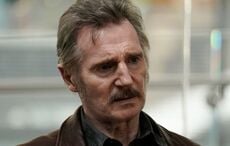Over the past several years there have been many fans of the 1952 film, “The Quiet Man,” who have been hoping and praying that the iconic cottage featured in the film would someday be restored. Those who have visited the site of the actual cottage are often dismayed to find that the “wee humble cottage” known as White O'Morn is today not much more than a pile of stones overgrown with vegetation. There are those within the “cottage restoration movement” that have tried to force the owner of the property to sell the cottage (he won't), attempted to initiate compulsory purchase orders (denied by the Irish government), and preservation orders (again, denied by the Irish government). After finding themselves thwarted in their attempts to wrest control of the cottage away from the owner, they have resorted to spreading rumors that the owner promised to restore the cottage but has instead allowed it to crumble and deteriorate into a pile of rubble.
Unknown to most folks, however, is that when the current owner purchased the property, the cottage had already been reduced to ruins, and the property had long been used as a grazing area for cattle and sheep. The property had been placed up for sale, and it was only after reducing the sale price, and unable to find any other buyers, that the property was sold to Mr. Greg Ebbitt of California. That was in 1984. Mr. Ebbitt was thrilled to purchase the property as he was, and is, a long time fan of the film. He purchased the property with every intention of rebuilding the cottage, however, after several setbacks, including an inability to interest any local workmen in the project, Mr. Ebbitt was forced to shelve his plans for a restored cottage until a later date. It would appear that later date has finally come at last. Well, at least maybe.
At this time, there are two organized groups working toward the rebuilding, restoration and protection of the Quiet Man cottage. The older of the two groups, the Save The Quiet Man Cottage Facebook group was founded by Mr. Mike Ward in January 2010. This group has been working closely with the owner and the Irish government to draft a plan that will not only be agreeable to both the owner and the government, but one that will also be beneficial for both and allow fans from around the world to come and enjoy a restored cottage as well.
The second group is the White O'Morn Foundation Facebook group, which was founded a little over a year later in 2011 by Mr. Patrick McCormick. Although McCormick's group not engaged in any actual restoration efforts since their founding almost three years ago, they have recently embarked on what they believe will be a successful plan to restore the cottage. They have launched an online petition to have the cottage placed on the Register of Protected Structures by the Galway County Council. Their petition is scheduled to be presented to the council in early May. Neither McCormick nor his group have worked with the owner in their endeavor, nor have they worked with the Irish government to this end. McCormick has, however, intimated several times that his group's petition has the full support of actress Maureen O'Hara, who appeared in the iconic 1952 film.
McCormick's spokesperson and partner in this endeavor is Ms. June Parker Beck, who claims to be Maureen O'Hara's official archivist and operator of the official Maureen O'Hara website. Ms. Beck has stated that when Maureen O'Hara learned of the petition she immediately signed it. Beck quoted Miss O'Hara as saying, “If you think about Duke, John Ford and all the people who worked on the picture it is sad to see the cottage in a shambles. How can anyone say anything but wonderful things about it, and see to it that it is restored for them and in their memory – and for Ireland?” Beck went on to say regarding the petition started by McCormick and herself, “The beauty of this is that the owner does not relinquish his property, but as historical property it would then be eligible for developmental grants and funding.”
Unfortunately, however, there are other aspects of McCormick and Beck's petition that they avoid mentioning, and for good reason since they may very well result in the cottage never being restored.
Ms. Máirín Doddy, Architectural Conservation Officer for the Galway County Council, responded to a request for information regarding McCormick and Beck's petition. In her response, Ms. Doddy stated that if the Quiet Man cottage “was to be included in the Record of Protected Structures, it would be included as it currently exists.” This is important to note, because “as it currently exists” includes not only the cottage ruins, but also a decrepit 1950's-1960's era house that sits in shambles only a few meters away from the cottage on the same piece of property.
Of course, one might think that this abandoned shell of a house could simply be bulldozed and removed. But then, one would be very wrong to think so. According to a publication produced and distributed by the Galway County Council titled, “A Guide to Protected Structures in County Galway,” if a structure is restored or rebuilt, “The obligation to preserve a protected structure applies to all parts of the structure, including its interior, all land around it, and any other structures on that land. The obligation also applies to all fixtures and fittings forming part of the interior of a protected structure or of any structure on land around it.”
Did you catch the part that says “The obligation to preserve a protected structure applies to … any other structures on that land”? This means that not only will the cottage itself have to be protected and preserved, but also the monstrosity of a ruined house that is currently falling in on itself only a few meters away from the cottage.
Additionally, before the cottage and the ruined house can be rebuilt and restored (as rebuilding and restoration efforts will affect the entire property), any and all protected species such as bats and badgers, as well as habitats and micro-habitats for plants and vegetation such as lichens and moss must be protected as they may later be colonized by groups of animals, including protected species. Because the land is currently being used as a grazing area for cattle and sheep, the cottage ruins, and also the ruins of the house immediately adjacent to the cottage ruins, will have to be fenced off, and a ground maintenance regime introduced to the area. This is according to the council's publication, “Ruins - The Conservation and Repair of Masonry Ruins.”
It is also important to note that both the cottage and the abandoned house next to it, were homes. They were not film sets, they were not museums, they were not tourist attractions, they were homes. This is important because according to the Galway County Council, “Restoration of a ruin for reuse should not be undertaken lightly. … The new use should be similar or close to the original use.” The original use, of course, being a home, a private residence. Not a museum. Not an interpretive center, but a home. (See council publication, “Ruins - The Conservation and Repair of Masonry Ruins). And if the restored cottage and restored house are to made accessible to the public, before that can happen it is quite likely that Ministerial Consent will first have to be procured. Given the proclivity of the property to flood, as well as a lack of proper parking or other facilities on the property, Ministerial Consent may not be as forthcoming as some would like.
It is possible, of course, that neither McCormick nor Beck were or are aware of regulations concerning protected structures, and if such is the case then one would hope they would seek an alternative method of preserving and protecting the cottage. One that would allow the cottage to become a museum of sorts, and one that would allow fans access to it rather than simply closing it off and ensuring its sure and certain complete demise.
Here's an RTE News report from 2012 on the cottage:




Comments